24 March, 2000
Folin-Denis Assay: Part 2
Question 34: What is the only whale that will regularly eat warm-blooded
animals, including, birds, seals, and other whales?
Continued...
Before we start working with the samples, we set up a standard curve to
compare our samples against. Katrin and I make six concentrations with a
compound that is similar to the polyphenolics we are looking at in the
macroalgae. We use a standard solution of 1 mg/ml. Then we dilute it so our
standard curve solutions have concentrations of 0, 0.5, 1, 5, 10 and 20 ug/ml.
(ug is the abbreviation for micrograms, 1000 ug = 1 mg) We will also have to
make sure we dilute the samples so their polyphenol concentrations fall within
the standard curve concentration values. If they go outside the curve, the
measurements are less reliable.
We treat these standard solutions with the Folin-Denis and sodium solutions
that dye the standards according to their concentrations. The lower the
concentration, the lighter the color that solution will turn. After they sit
for 30 minutes to process completely, we run the standard curve solutions
through the spectrophotometer to calibrate it. Then we can move on to the
samples.
First, we take the samples out of the refrigerator where they have been
soaking in methanol for 24 hours to extract the chemicals out of the
macroalgae. We want only the liquid, no chunks. So the samples go to the
centrifuge, which spins so fast that all the solid material collects at the
bottom of the vial. The liquid is divided into two treatments.
One (PVPP-, meaning "without PVPP") has the dyeing solutions added to it
right away, is processed for 30 minutes and is then measured in the
spectrophotometer. The other (PVPP+, meaning "with PVPP") is first treated
several times with PVPP. PVPP (polyvinylpolypyrrolidine, a white powder) is a
polymer (plastic) that binds to the polyphenolic compounds we are interested
in. After each treatment with this substance, we transfer only the liquid to
the next treatment and throw away the PVPP and the polyphenolic compounds
bound to it. Then the Folin-Denis and sodium solutions are added, and after
30 minutes steeping time, we measure the samples with the spectrophotometer.
By comparing the measurements of the two treatments (liquid with all
chemicals and liquid with only the ones we do not want) we can calculate the
concentration of the polyphenolics that we are interested in. We take the
absorption of the minus treatment (all chemicals) and subtract the absorption
of the plus treatment (chemicals we are not interested in) to get the
absorption of the polyphenolic compounds which have been removed.
The spectrophotometer measures the amount of light absorbed by a liquid
sample. It can be set to use a wide spectrum of light or only a certain
wavelength. We are using 725 nm light, the best wavelength for the kind of
parcticles we are working with. Without a standard curve of known
concentrations to refer to, the spectrophotometer can give only absorbence.
Once we run the standard curve solutions through it and tell it what
concentrations they are, the spec can identify unknown concentrations.
The spectrophotometer has a chamber with no light leaks. In that chamber is
a holder for a cuvette (similar to a tiny square test tube) that contains our
solutions. We put each sample inside, close the cover and then hit the button
that signals the machine to shoot a beam of light through it. The spec
records how much of the light the sample absorbs (the darker the dye color,
the more light it absorbs and the higher the concentration of the compound).
Then we work out mathematically all the dilutions that have taken place and
get our measurement of how many micrograms of polyphenolic compound are in
each milligram of dry macroalgal tissue. Whew, done!
It is still snowing today.
Answer 33: Over half of the surface area, about 57%, of the Southern Ocean is
covered by ice by the end of winter (September).
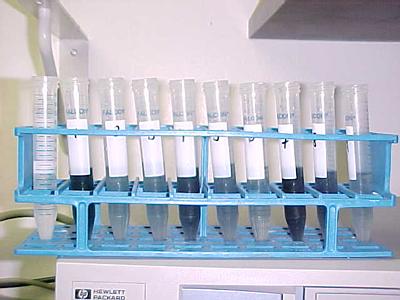
Folin-Denis treated samples ready to be measured. Each group of three vials (from the right side) came from the same plant. Every third vial (from the right side) has the same type of tissue from a different plant.
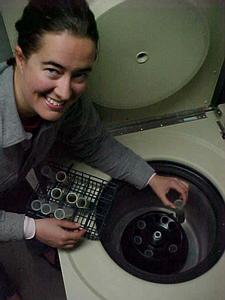
Samples going into the centrifuge.
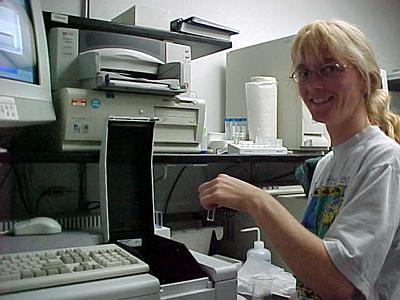
Katrin placing cuvette into spectrophotometer.
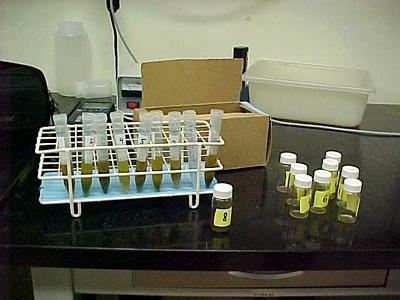
Extracted samples ready to be centrifuged.

Standard curve solutions ready to measure.
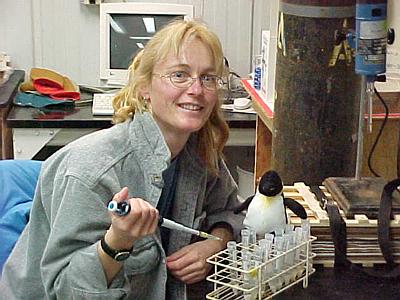
Katrin setting up PVPP+ samples.

Contact the TEA in the field at
.
If you cannot connect through your browser, copy the
TEA's e-mail address in the "To:" line of
your favorite e-mail package.
|
